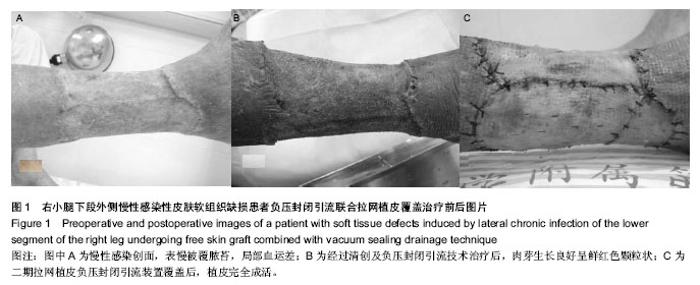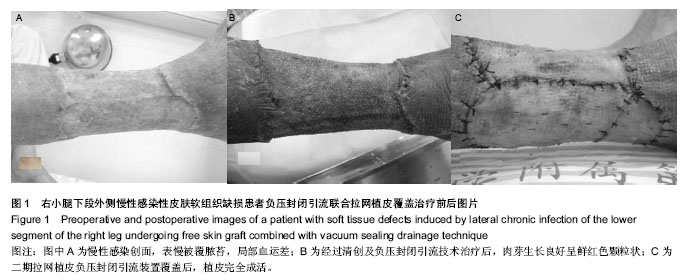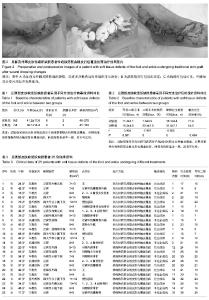| [1] Fleischmann W,Strecker W,Bombelli M,et al. Vacuum sealing as treatment of soft tissue damage in open fractures. Unfallchirurg.1993;96(9):488-492.
[2] Cedidi C,Berger A,lngianni G.The two-stage concept with temporary subcutaneous implantation of a vacuum sealing system: an alternative surgical approach in infected partial abdominal defects after lapratomy or abdominoplasty.Eur J Med Res.2002;7(9):399-403.
[3] 廖前德,许鉴,翁晓军,等.封闭式负压引流联合反植皮一期闭合开放性创伤截肢创面的临床分析[J].中国修复重建外科杂志,2012, 26(5):558-562.
[4] 段军,张远金.封闭式负压引流技术应用于植皮术的临床疗效[J].中国修复重建外科杂志.2011,25(2):251-252.
[5] 梁尊鸿,潘云川,王挥斯,等.封闭式负压引流技术联合植皮治疗大面积皮肤撕脱伤合并感染[J].中国修复重建外科杂志,2012, 26(9): 1145-1147.
[6] 王新江,马文龙,杜志军,等.VSD结合游离植皮治疗儿童下肢大面积皮肤缺损[J].组织工程与重建外科杂志,2013,9(1):35-36.
[7] 韩家宏,雷楚林,李仁鹏.负压封闭引流技术在下肢大面积皮肤缺损合并感染的应用[J].中国烧伤创疡杂志,2010,22(6): 445-447.
[8] 蒋国群,胡永才,周海洋,等.负压封闭引流技术辅助下游离植皮修复骶尾部压疮疗效观察[J].现代医药卫生,2013,29(12): 1861- 1862.
[9] 于铁强,左玉明,王月光,等.封闭式负压引流技术联合腓肠神经营养血管皮瓣修复儿童足跟部软组织缺损[J].中国修复重建外科杂志,2013,27(5):637-638.
[10] 阮海燕,钟永翔,林晓.应用封闭式负压引流在大面积皮肤缺损合并感染疗效分析[J]. 中华医院感染学杂志,2013,23(12): 2899-2901.
[11] Li RG,Yu B,Wang G,et al.Sequential therapy of vacuum sealing drainage and free-flap transplantation for children with extensive soft-tissue defects below the knee in the extremities. Injury.2012;43(6):822-828.
[12] 任高宏,余斌,王钢,等.游离组织瓣联合游离植皮负压封闭引流技术修复肢体大面积软组织缺损[J].中华创伤骨科杂志,2012, 14(10):844-849.
[13] 李靖,陈绍宗,许龙顺.封闭负压引流技术对兔耳创面毛细血管密度及创面愈合的影响[J].中国临床康复,2004,8(5):904-905.
[14] 曹大勇,陈绍宗,汤苏阳,等.封闭式负压引流技术对人慢性创面血管生成的影响[J].中国临床康复,2004,8(2):264-265.
[15] Labanaris AP,Polykandriotis E,Horch RE.The effect of vacuum-assisted closure on lymph vessels in chronic wounds.J Plast Reconstr Aesthet Surg.2009; 62(8):1068 -1075.
[16] Petzina R,Gustafsson L,Mokhtari A,et al.Effect of vacuum-assisted closure on blood flow in the peristernal thoracic wall after internal mammary artery harvesting.Eur J Cardiothorac Surg.2006;30(1):85-89.
[17] Venturi ML,Attinger CE,Mesbahi AN,et al.Mechanisms and clinical applications of the vacuum-assisted closure (VAC) Device: a review.Am J Clin Dermatol. 2005;6(3):185-194.
[18] 曲家富,闫荣亮,王良,等.负压封闭引流技术结合肌瓣转移游离植皮治疗小腿及足踝部软组织缺损伴骨外露[J].中华创伤骨科杂志, 2013,15(4):316-319.
[19] 邓凯,陶圣祥,夏成焱,等.负压封闭引流联合游离植骨血管化的研究[J].中华实验外科杂志,2013,23(10):2185-2187.
[20] Petkar KS,Dhanraj P,Kingsly PM,et al.A prospective randomized controlled trial comparing negative pressure dressing and conventional dressing methods on split-thickness skin grafts in burned patients.Burns. 2011; 37(6):925-929.
[21] 谢志进,方跃,王彦川,等.高分子泡沫材料覆盖负压封闭引流用于四肢皮肤撕脱伤[J].中国组织工程研究,2012,16(25): 4745-4750.
[22] 李陵江,常恒,常晶晶,等.聚乙烯乙醇水化海藻盐封闭式负压引流修复骨外科创面[J]. 中国组织工程研究,2013,17(47): 8282- 8287.
[23] 张向阳,胡雁,胡斌,等.VSD在不完全皮肤撕脱伤修复中的应用探讨[J].生物医学工程与临床,2010,14(5):424-426.
[24] 徐海栋,赵建宁,赏后来,等.生物材料创面敷料封闭负压引流在大面积创面植皮中的应用[J].中国组织工程研究,2012,16(3): 543-546.
[25] 徐海栋,赵建宁,卢俊浩,等.创面敷料封闭负压引流治疗慢性创面[J].中国组织工程研究,2013,17(16):3026-3032. |



